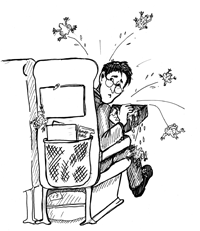STRANGE BUT TRUE- Loose frogs: How bursting bags affected this flight

DRAWING BY DEBORAH DERR McCLINTOCK
Q. How did a colony of New York frogs fare when flown via commercial airline to a biology lab in California, back in those looser security days a while ago? –C. deGaulle
A. Deciding against putting the frogs in checked luggage, the young lab assistant Bill carefully put them in plastic bags with water and air, then into his carry-on suitcase, says Jane Riggs in Science magazine.
Unfortunately, that's where the meticulous thinking ended. As soon as the plane gained altitude, the change in air pressure caused the bags to burst. When Bill opened the carry-on and saw what had happened, he hurriedly asked every flight attendant he could find for glasses of water so he could refill and retie the bags. Too late, of course: Out jumped the tiny creatures and soon they were everywhere, forcing attendants to track them down under seats, down aisles, etc.
"Baffled passengers looked on, trying to determine the source of the commotion," Riggs writes. Happily, the frogs were all eventually rounded up and transported to their new home across the continent, where they prospered for many years.
Q. If you donate blood for a transfusion, are you passing along your DNA "fingerprint" to the recipient? Let's hope the person isn't criminally inclined! –J. T. Ripper
A. Studies show donor DNA persisting for days or longer, though its presence is unlikely to alter genetic tests significantly, says Mount Sinai School of Medicine's Michelle N. Gong in Scientific American magazine. Red blood cells, the primary component in transfusions, have no nucleus and no DNA. Transfused blood does, however, host many DNA-containing white blood cells, or leukocytes— around a billion in one pint of blood. Even filtered blood can have millions of these.
A process called polymerase chain reaction can amplify minuscule amounts of genetic material for detection and identification. In studies, amplification of male genes in female transfusion recipients have shown donor DNA enduring for up to seven days. And female trauma patients receiving large transfusions showed the donor leukocytes staying for up to a year and a half. All of these however used very sensitive donor amplification techniques.
"In studies where genes common to both donors and recipients were amplified, the results reflected the dominance of the transfusion recipient's own DNA, showing the donor's DNA to be a relatively inconsequential interloper," Gong says.
Q. Ever try "casting out 9s" at a birthday party? This'll wow the kids, and maybe the far-from kids too. –F. Fellini
A. Have someone jot down any number, such as 106, and keep it secret from you. Next, he (she) should multiply it by 9, then circle any non-zero digit in the answer, and add together all the other digits and give you the total.
Now you're going to "guess" the mystery circled digit.
In the 106 example, he multiplies by 9 to get 954, then circles, say, the mystery 4, adds 9 + 5, and gives you the 14. You quickly tell him the mystery number is 4. How did you do it? You simply subtracted 14 from the next higher multiple of 9 (18 in this case), which yields 4 (18 - 14). (Note: If the total reported to you is itself a multiple of 9, you know immediately a 9 was circled.
Most people will be amazed. It works because any time a number is multiplied by 9, the digits in the answer add up to a multiple of 9. So however much the reported sum falls short of a 9-multiple will be the mystery digit.
Q. Imagine newborn identical twins Adam and Andrew receiving the best medical, dietary and social upbringing of their day, and yet adult Adam turns out to be about three inches taller than adult Andrew and scores roughly 20 points higher on the same intelligence test. What's the trick here? –A. Sloop
A. And quite a trick it would be to send Adam forward via time machine to be similarly raised by a family of 2050, since the extra three inches is about what males gained on average from mid-20th century to the turn of this century, as determined from data both in the U.S. and Britain, report researchers W. H. Angoff and R. Lynn.
Since height is largely genetic, subtle non-genetic (environmental) factors must be at play to help account for the three-inch difference. Harvard geneticist Richard Lewontin once called this the "fertile field effect," referring to how one field of corn plants well nurtured could wind up on average taller than an identical field not so well nurtured.
For similar reasons (not well understood), Adam would wind up with an IQ score maybe 20 points higher than his twin brother, since IQ scores go up roughly 6 points each generation, called the Flynn effect. The effect is generally masked because scores are periodically re-normed.
~
Send Strange questions to brothers Bill and Rich at [email protected].
#